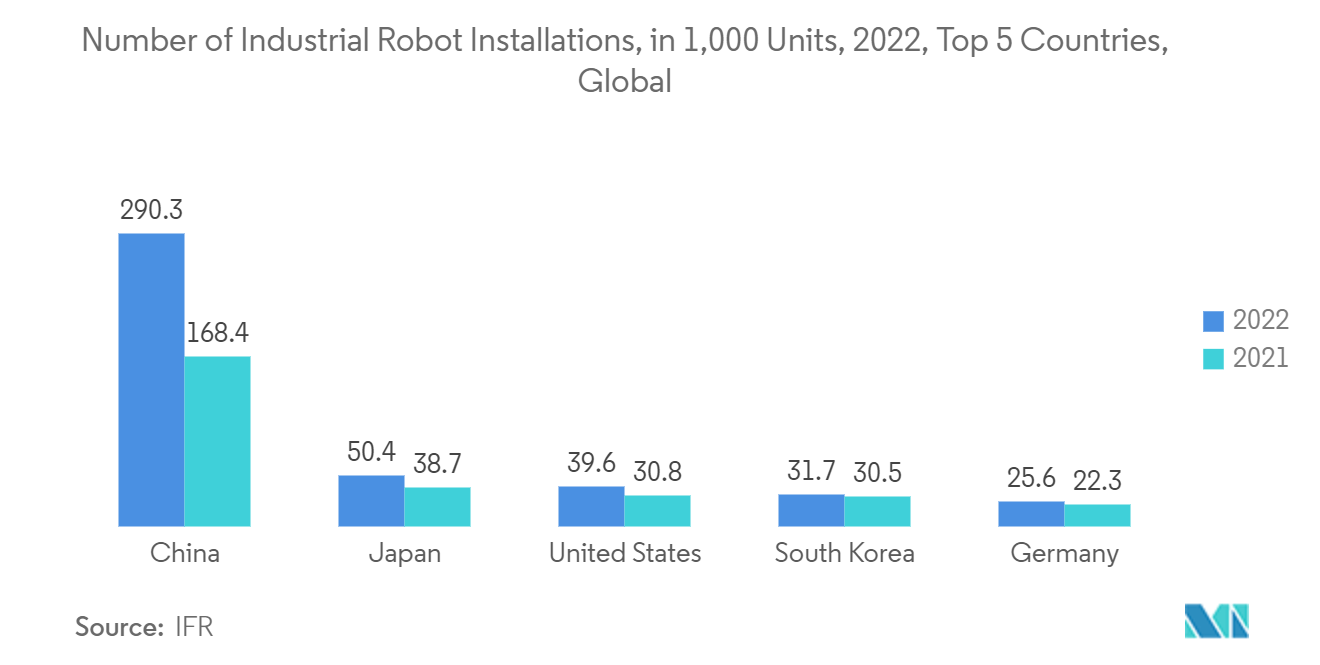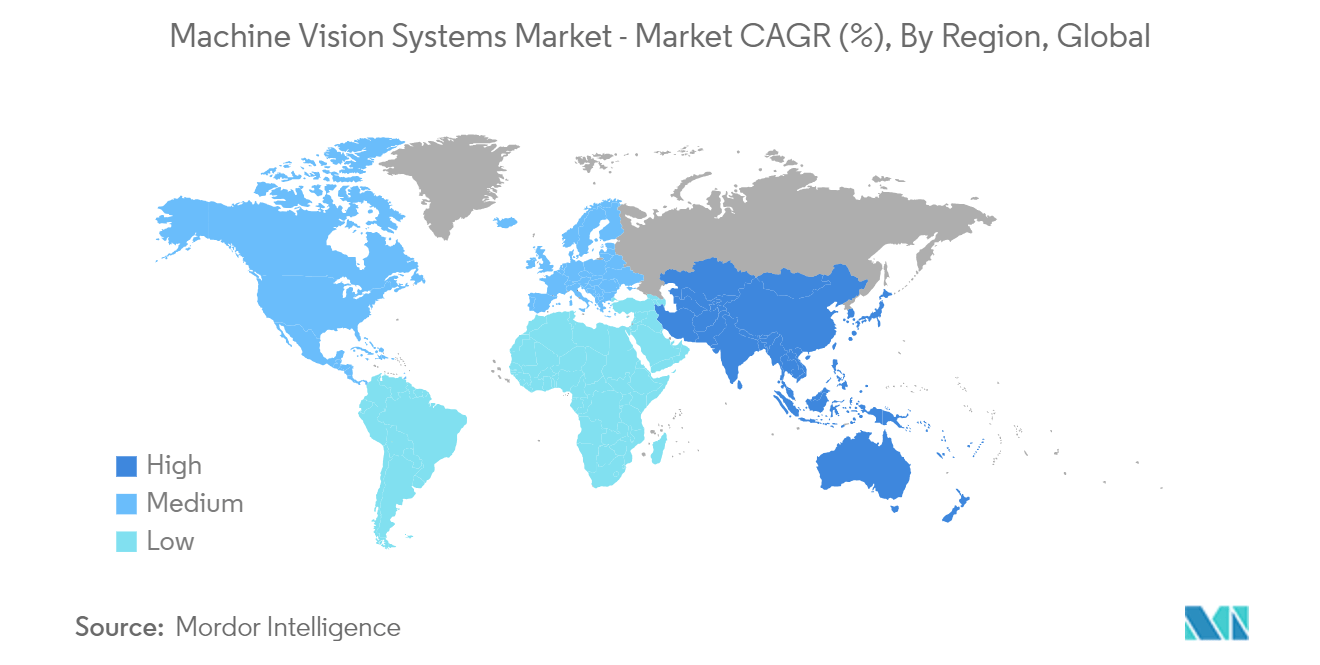Market Trends of Machine Vision Systems Industry
Cameras to be the Largest Hardware Segment
- Machine vision cameras play a crucial role in the industrial image processing chain. These cameras utilize a particular protocol to communicate with a computer, which then analyzes the image data and can even adjust the camera's settings. The applications of machine vision cameras are diverse and extensive. They can be utilized for production control, managing object flow, inspecting surfaces, manufacturing electronic components, and guiding robots.
- Machine vision cameras are capable of transforming an optical image into an analog or digital signal. These cameras employ PC-based processing hardware and software algorithms to analyze images, videos, and data, facilitating the automation of manual tasks. On the other hand, traditional smart cameras are self-contained units that integrate a machine vision camera, a processor, and lighting within a compact enclosure. These smart cameras have the ability to capture and analyze images and data without requiring a separate PC.
- Smart cameras are becoming a popular hardware component in the MV System. They have greatly simplified the process of designing machine vision systems by integrating lighting, image sensors, software, and I/O. Over time, the capabilities and specifications of smart cameras have expanded. This includes the introduction of models with larger image sensors, the emergence of embedded vision cameras that can function as smart cameras, and the development of new cameras that are capable of executing deep learning and artificial intelligence tasks.
- Machine vision has emerged as a cutting-edge advancement in camera technology, revolutionizing multiple industrial sectors such as logistics, manufacturing, and smart devices. With the advent of smart camera technologies, manufacturers can effortlessly develop and implement machine vision models tailored to their customer's specific requirements, helping customers gain comprehensive and actionable insights from valuable data. The market is poised to witness significant growth due to the rising popularity of smart cameras, which offer enhanced processing capabilities in compact form factors.
- For instance, in May 2023, Zivid launched a revolutionary line of its latest 3D color cameras, poised to make a significant impact on the machine vision and automation sectors. This development empowers the company to further enhance its capabilities, enabling customers to optimize efficiency and productivity across various applications such as de-palletizing, bin-picking, pick-and-place, assembly, packaging, and quality control. Such developments are expected to increase the potential of the market opportunities and drive the market at a significant rate.
- The utilization of technology spans numerous industries, encompassing robotic guidance and automation, quality control and inspection, as well as mapping. The growing adoption of robotics in the manufacturing sector is anticipated to amplify the potential of cameras for machine vision systems, driven by technological advancements and the rising demand for automation in various industries. For instance, according to a survey published by the International Federation of Robotics (IFR) in 2023, there was a 5% year-on-year growth in the installation of industrial robots in factories worldwide, with a total of 553,052 robots installed in 2022. Asia accounted for 73% of the newly deployed robots, followed by Europe with 15% and the Americas with 10%.

Asia-Pacific is Expected to Hold Significant Market Share
- China is one of the world's fastest-growing countries with a high industrial production rate. This acts as a driver for the machine vision systems market in the country. Investments are planned to improve the quality of growth, address environmental issues, and reduce overcapacity. The number of companies deploying factory automation, process, and robotics technologies in the country is smaller than the enormous scale of its manufacturing facilities and the number of workers it employs. This represents a big opportunity for companies in China's machine vision sector.
- Japan also holds a significant position in the semiconductor and electronics industries as it is home to some essential semiconductor manufacturers. According to WSTS, the semiconductor industry revenue in Japan grew by 14.2% in 2022, and it is expected to grow further over the coming years. Furthermore, the country's growing automotive industry is also expected to support market growth over the forecast period as various steps have been taken to increase the adoption of autonomous vehicles.
- In South Korea, the automotive industry is flourishing, driving the demand for machine vision systems. Growing consumer demand and supportive government policies are among the significant factors driving the country's adoption of autonomous and electric vehicles. According to a report published by the Ministry of Land, Infrastructure and Transport (South Korea), around 390 thousand electric vehicles were registered in South Korea in 2022, with a sharp increase recorded after 2013. Together with hybrid and hydrogen vehicles, the share of environment-friendly vehicles among the total number of registered vehicles in South Korea was about 6.2%.
- India's industrial automation sector has been revolutionized by the addition of digital and physical technologies in manufacturing to deliver optimal performance. Additionally, emphasis on zero-waste manufacturing and a shorter time-to-market has increased market growth.
- The rest of Asia-Pacific comprises Taiwan, Singapore, Indonesia, Malaysia, Thailand, Australia, etc. In Indonesia, the onset of Industry 4.0 is driving the market studied, with a focus on implementing automation systems in the food and beverage, textiles and clothing, automotive, chemical, and electronics industries. Cross-government initiatives between Indonesia and Germany are strengthening the start-up ecosystem in the country.
- The presence of strong electronics and semiconductor markets in the region has pushed multinational industries to establish their operations there. This has been a significant factor in the growing demand for new solutions. Cost-cutting and high-output solutions are a few sought-out solutions in the consumer goods and food processing industry. Automation serves these purposes and brings additional benefits, such as quality adherence and real-time assessment of the products. These developments have been critical in demand generation in these regional markets.

